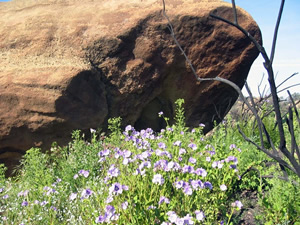General Description
Topography
The SSFL occupies 2,849 acres of rocky terrain with approximately 700 feet of topographic relief near the crest of the Simi Hills. Area IV is between 1,880 feet and 2,150 feet above sea level and is relatively flat.
Geography
ETEC is situated on rocky terrain and occupies an upland area known as Burro Flats, which sits at the crest of the Simi Hills, near their eastern end of Area IV. Its overlying soils consist of weathered bedrock and alluvium (unconsolidated sand, silt and clay materials that have been eroded primarily from the surrounding Chatsworth and Martinez Formations. Several geological faults cross the site.

Climate
The climate at the vicinity of the SSFL is classified as Mediterranean subtropical, which corresponds to an average temperature of 50 Fahrenheit in the winter and 70 Fahrenheit in the summer. Rainfall averages approximately 18 inches per year.
Habitat
The undeveloped areas within the SSFL site, both in open space and in the natural areas surrounding the developed site areas, consist of a large area of diverse habitats. Within the SSFL and open space, 16 different habitat types occur but the majority of Area IV is covered by coast live oak woodland, southern willow scrub, baccharis scrub, native grasslands, and nonnative grasslands. The DOE consults with the U.S. Department of Fish and Wildlife to ensure any activities at the site do not harm endangered species.
Wildlife
The SSFL is home to a range of wildlife. A survey conducted at the site identified sixty nine bird species and thirteen mammal species at SSFL, including Area IV. Employees and visitors often spot mule deer, scrub jays, turkey vultures, jack rabbits, quail and rattlesnakes.
Water Resources
A shallow groundwater system exists in the surface soils at small isolated locations. A regional groundwater system exists in the deeper fractured Chatsworth Formation. Groundwater is not used as a source of drinking water for the nearby communities or at SSFL.